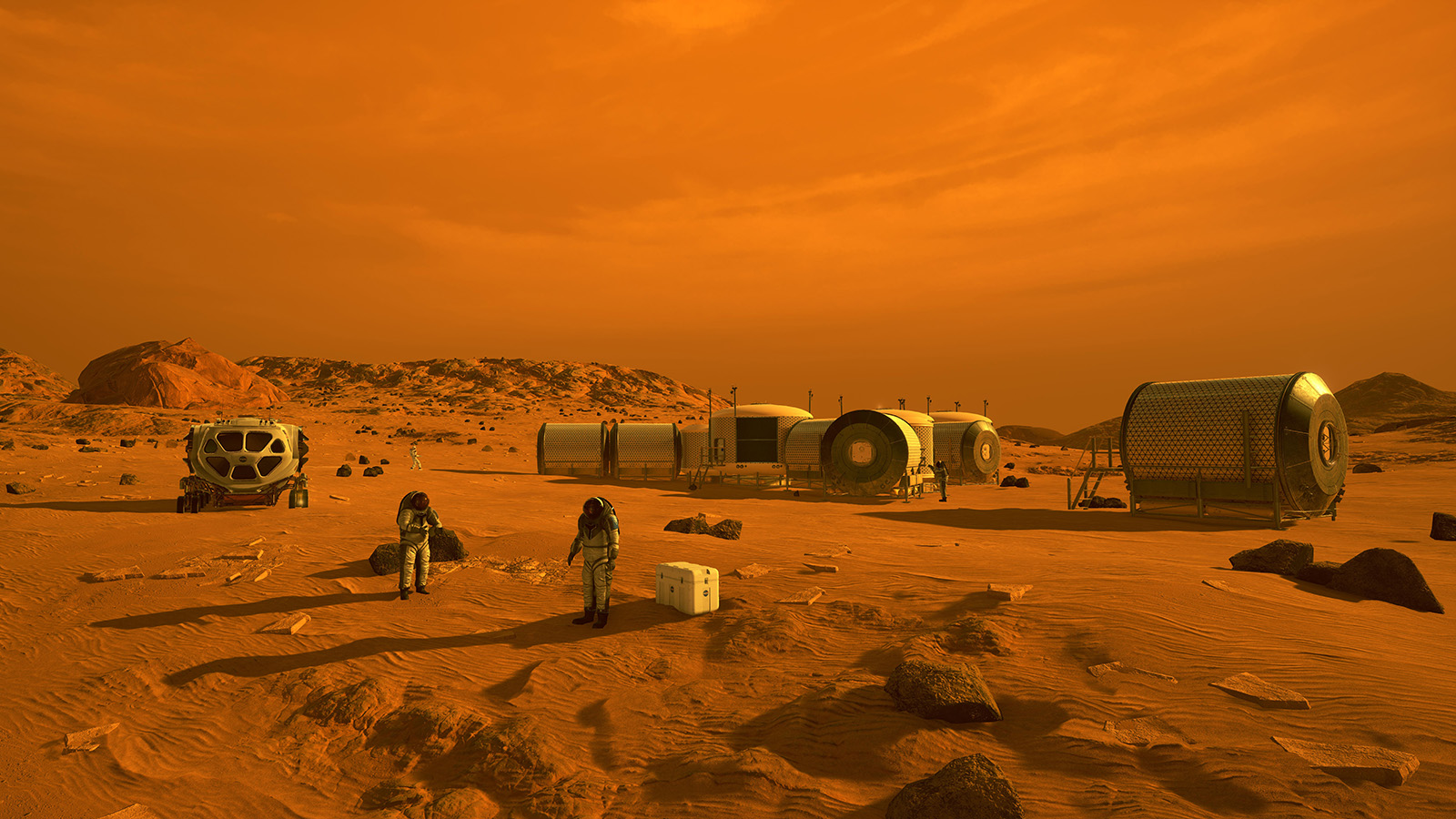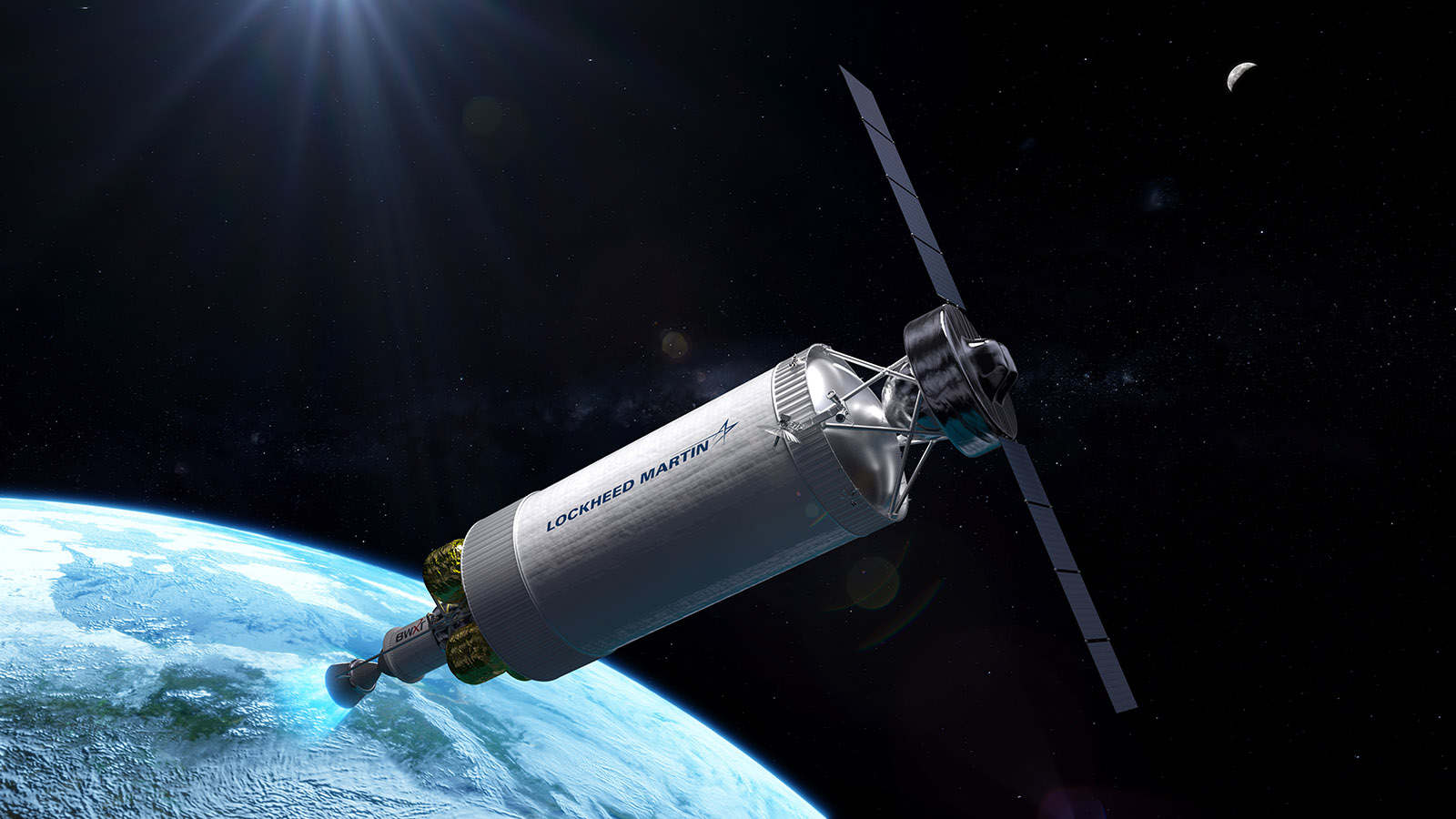Stay Up to Date
Submit your email address to receive the latest industry and Aerospace America news.
NASA and DARPA think nuclear thermal propulsion could be the best way to get humans to Mars. Elon Musk is keeping his faith in the brute force of burning hydrocarbons. Who is right? It turns out either could work, but there are a lot of “ifs” for both strategies. Jon Kelvey has the analysis.
Elon Musk told an audience in 2016 that his vision of getting a million colonists to Mars could be achieved by sending 100 people at a time on six-month journeys aboard his massive Starship spacecraft. Despite Starship’s powerful engines, that transit time is an issue because it is not particularly fast. NASA’s Perseverance rover, for instance, took six months and two weeks to arrive in 2021 by taking advantage of the alignment of Earth and Mars that happens every 26 months. Perhaps aware of this, in later tweets, conference keynotes and video interviews, Musk cut his estimated transit time down to three months or even one month, without explanation.
His reason for wanting to get there fast might not just be his determination to see Mars colonized in his lifetime. Without a radiation shield of some kind, Musk’s colonists would be pummeled by galactic cosmic rays consisting of fragments of atoms traveling at incredible velocities that can damage DNA. Because humans or other living things haven’t ventured past the moon, where Earth’s protective magnetosphere fades into nothing, the medical community isn’t sure exactly how bad the effects of this radiation could be. Researchers have simulated GCR and subjected tissues and small animals to it to find out, but there’s not certainty yet. In his 2016 remarks, Musk characterized the risk as “relatively minor” and “not deadly.” NASA, however, is not taking chances. In low-Earth orbit, the magnetosphere doesn’t block all radiation, so NASA allows an astronaut to accumulate up to 1 sievert of radiation over the course of a career, which is equivalent to 10,000 chest X-rays and 160 times the annual average does at sea level on Earth. Astronauts on the International Space Station are exposed to around 200 millisieverts per year.

For Mars, “a roughly 900-day mission, which is what we’re expecting for a mission to last with traditional propulsion, will get them exposed to 1 sievert per year,” says Emmanuel Urquieta Ordonez, the chief medical officer for the Translational Research Institute for Space Health at the Baylor College of Medicine.
In other words, an astronaut’s career would be done after one mission to Mars and back of about two and half years. On top of that, the longest anyone has spent in space on a single stint is 437 days, a record set by cosmonaut Valeri Polyakov in the 1990s. Surviving the radiation tops a list of other medical questions that includes how to combat muscle wasting and overcome the psychology effects of being away from Earth for so long.
With all this in mind, the conventional space community is trying to find an alternative to conventionally fueled rocket engines.
“You have to look at what can the human body take,” says Robert Moses, a retired aerospace engineer from NASA’s Langley Research Center in Virginia.
One could try to incorporate shielding of some kind to block radiation during the journey. But as Moses found when analyzing adding a layer of polyethylene cladding to a hypothetical spacecraft, it could add at least a thousand metric tons of additional mass, making the journey impractical.
Instead of hauling more mass as shielding, he says, you can just go faster. “Fast transits, some 200-day or so round trips, would in a major way mitigate the radiation and microgravity health effects for humans.”
Nuclear propulsion could be the most promising alternative to conventionally fueled rockets, including Musk’s methane- and liquid-oxygen-powered Super Heavy boosters and Starship upper stages that colonists would ride in. Musk has shown no interest in SpaceX counting on the technology: “Nuclear thermal rocket for fast transit around solar system would be a great area of research for NASA,” he said on Twitter in 2019.
He was responding to a since-deleted post about nuclear thermal propulsion. In NTP, liquid hydrogen stored in tanks would be pumped through a nuclear fission reactor. The heat released from splitting uranium atoms would turn the hydrogen to gas that would be channeled out a nozzle to produce thrust. DARPA and NASA have a plan to test the technology in space in 2027 under DRACO, the Demonstration Rocket for Agile Cislunar Operations program. Nuclear propulsion could achieve a one-way transit time of 100 days, according to NASA.
Why isn’t Musk on board?
For starters, he wants to get his million people to Mars and quickly, considering the brashness of the goal. In 2019, he posted on Twitter that this could be accomplished by 2050. He would be 79 then. Last year, he underscored to biographer Walter Isaacson: “We need to get to Mars before I die.”
These comments suggest that the development timeline matters more to Musk than the transit time, despite his vaguely described determination to shorten it.
“SpaceX is not trying to invent something completely new. They’ve been using the existing technology in a different way,” says physicist and space consultant Laura Forczyk.
In other words, a Starship is propelled from the pad not by some exotic propulsion technology but by the brute force of 33 conventionally fueled Raptor engines mounted on a Super Heavy booster. Once in space, a Starship spacecraft would fire its six Raptors to make the journey to Mars (after a quick stop to fill up its propellant tanks).

Musk seems not to want to hitch his vision to development of nuclear technology by government agencies. The United States has started and stopped a variety of space nuclear propulsion efforts since the 1950s. There was Project Rover, started in 1955 within the Air Force and transferred to NASA when the space agency was created, becoming Rover NERVA, short for Nuclear Engine for Rocket Vehicle Application. There were six ground firings of NERVA engines between 1964 and 1969, but one was never flown in space. Budget cuts to NASA led to the program’s cancellation in 1973.
The DRACO team aims to achieve what NERVA could not, and it has a busy year on the docket. Over the next nine months, plans call for beginning construction of the nuclear reactor and engine, DRACO Program Manager Tabitha Dodson told attendees at last year’s AIAA SciTech Forum in Maryland. Testing with engineering units, including a cold-flow test of the engine, in which liquid hydrogen will be pumped through an inactive reactor core, is scheduled to occur at NASA’s Marshall Center sometime “in the fall,” she added.
A DARPA document from 2022 said the final phase of the program is scheduled to begin in January and culminate in the installation of the reactor engine aboard the spacecraft, built by Lockheed Martin, in preparation for the 2027 launch and in-orbit demonstration.
Setting aside questions about the staying power of government projects, it’s also difficult for private companies to work with nuclear materials from a regulatory standpoint, Forczyk notes. Applying for licensing with the U.S. Nuclear Regulatory Commission would be another administrative burden for SpaceX, and the company has already seen delays to Starship tests flights due to licensing trouble with FAA. Musk at one time had hoped to complete an orbital test flight of the vehicle in October 2022 and is now reportedly targeting May for that attempt, following last month’s largely successful suborbital flight.
Musk’s reliance on chemical propulsion is not without justification in physics. There is nothing magical about NTP that makes it inherently more capable of going faster than chemical rockets, according to Benjamin Jorns, a space propulsion researcher at the University of Michigan.
“If you’re willing to launch 1,000 Starships and use all those as your propellant tanks, you get to Mars in like, 30 days,” he says.
That’s because in frictionless space, the cruising speed that’s achieved is governed by how long an engine burns, and that time, in turn, is governed by how much fuel and oxidizer can be carried. In the case of Starship, perhaps Musk has in mind capitalizing on that to slash the six-month transit time he spoke of in 2016. So far, Musk and SpaceX have only roughly described plans to launch between four and 16 propellant tanker versions of Starship into Earth orbit to provide 1,200 metric tons of propellant. A SpaceX YouTube video set to dramatic music shows a Starship docking with a tanker, or at least it looks like that. There is no text or narration to fully describe the architecture.
Dennis Bushnell, who retired from NASA Langley last year as the chief scientist, thinks Musk is onto something. The chief obstacle to such a plan, he notes, is the cost of getting propellant from Earth into orbit. And Starship, like the Falcon series rockets before it, will reduce the cost of getting mass into orbit.
“Chemical fast transits are enabled by massively reduced costs of chemical fuel in orbit, which SpaceX proffers,” Bushnell says by email. Plus, “chemical can be done now-to-soon.”
As Musk put it in 2016: “Over time, there would be many spaceships. Ultimately, I think, upwards of 1,000 or more spaceships waiting in orbit.”
There are, of course, hurdles beyond tanking. Plans call for returning Starships to Earth to reuse them, and that would require creating propellant from ice and atmospheric carbon dioxide on Mars.
Historically speaking, Musk is in prominent company with his vision. In 1948, Wernher Von Braun sketched out a Mars expedition in an unpublished novel featuring 10 spacecraft weighing 4,000 tons [3,628 metric tons] each with a crew of 70 and requiring 5.3 million tons [4.8 million metric tons] of nitric acid and alcohol propellant, according to a NASA history of Mars mission planning. And yet by 1959, researchers at Lewis Research Center in Ohio (now NASA’s Glenn Research Center), were pitching high-thrust NTP spacecraft as superior vehicles for Mars missions. The researchers warned: “Current knowledge of radiation hazards is still not completely satisfactory.”
If the same speed, in theory, could be achieved by burning lots of fuel for longer, what’s the attraction of NTP? It’s the potential to double the fuel efficiency. A DRACO engine, for instance, could run twice as long as a chemical engine with an equivalent volume of propellant. Or for the same run time, it would go through half the propellant. An exact comparison is difficult without specific spacecraft and mission plans to analyze, and at the moment, neither of those exist. Starship has yet to reach orbit, and DRACO is still in development — Mars-capable NTP rockets will “take more than five years to make ready,” Bushnell says.

Worth mentioning is that NASA isn’t ignoring chemical propulsion and even more exotic approaches to each Mars. In its “Moon-to-Mars Architecture Definition Document” published in January, the agency analyzed four mission concepts: one centered on NTP, another on chemical rockets, a third on nuclear electric and another on solar electric propulsion. In the last two concepts, electricity would be generated to drive ion thrusters like the Hall Effect thrusters that maneuver many satellites today.
But “at this point, it’s just ideas and concepts and nothing with a budget,” Forczyk, the analyst, says. “The issue is that NASA’s budget is so very limited that all they can do are these limited studies.”
Questions about NASA’s commitment to nuclear propulsion could be justified. Budget figures suggest it is not the top priority. The agency is committed to funding DRACO at between $293 million and $360 million through the 2027 flight demonstration, NASA said in response to my questions, with $90 million per year allocated for fiscal years 2024 and 2025. And the fiscal 2024 appropriations bill passed in March allocated $110 million for NASA’s NTP work — with $10 million going “to accelerate technologies apart from the DRACO demonstration needed for an operational NTP system,” the statement said.
That funding pales in comparison with $5.819 billion in the spending bill allocated for the Space Launch System rockets and Human Landing System for NASA’s Artemis moon program, some of which would go to SpaceX, which is on contract to deliver two astronauts to the lunar surface in a Human Landing System variant of Starship in 2026. “You can see where the priorities are,” Forczyk says. “The priorities are getting to the moon before China.”
For the near term, the moon rather than Mars will be Starship’s. Under the terms of its Artemis III contract, the company must complete an uncrewed landing on the lunar surface before ferrying the Artemis III crew. Given the time constraints, those flights will likely take place before any SpaceX mission to Mars.
In the meantime, competing analyses of mission profiles and propulsion technology and development can continue. More time before a Mars mission will only mean more options.
“It’s exciting,” Jorns says. “People are actually legitimately talking about Mars. Competition is good, you know?”
About jon kelvey
Jon previously covered space for The Independent in the U.K. His work has appeared in Air and Space Smithsonian, Slate and the Washington Post. He is based in Maryland.
Related Posts
Stay Up to Date
Submit your email address to receive the latest industry and Aerospace America news.




